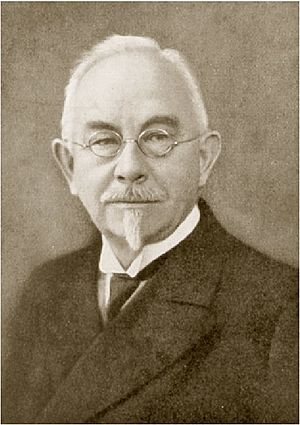Wilhelm Johannsen facts for kids
Quick facts for kids
Wilhelm Ludvig Johannsen
|
|
|---|---|
 |
|
| Born | 3 February 1857 |
| Died | 11 November 1927 (aged 70) Copenhagen, Denmark
|
| Nationality | Danish |
| Alma mater | University of Copenhagen |
| Known for | proving the constancy of the genome Coining gene, genotype and phenotype |
| Scientific career | |
| Fields | Genetics Plant physiology |
| Institutions | University of Copenhagen |
Wilhelm Johannsen (born February 3, 1857 – died November 11, 1927) was a Danish scientist. He was a pharmacist, a botanist (someone who studies plants), and a plant physiologist (someone who studies how plants work). He also became a geneticist, which is a scientist who studies how traits are passed down from parents to their offspring.
Johannsen is famous for creating some very important words in genetics. These words are gene, phenotype, and genotype. He also did important experiments with plants, which helped us understand more about how living things inherit traits.
Contents
Who Was Wilhelm Johannsen?
Wilhelm Johannsen was born in Copenhagen, Denmark. When he was young, he started training to be a pharmacist in 1872. He worked in pharmacies in Denmark and Germany. In 1879, he passed his exam to become a pharmacist.
In 1881, he started working at the Carlsberg Laboratory. He was an assistant in the chemistry department. There, he studied how seeds, tubers (like potatoes), and buds (like flower buds) use energy. He looked at how they rested (dormancy) and how they started to grow (germination). He found that certain chemicals could make dormant plants start growing.
Becoming a Professor and Plant Expert
In 1892, Johannsen became a lecturer at the Royal Veterinary and Agricultural University. Later, he became a professor there. He taught about plants and how they function.
His most famous work involved studying "pure lines" of common beans. These were beans that were genetically very similar. He discovered that even in these pure lines, the size of the seeds still varied. This variation was not due to genetics. Instead, it was because of things like how much food the parent plant got. It also depended on where the seeds were located in the bean pods.
What Are Phenotype and Genotype?
Johannsen's bean experiments led him to create the terms phenotype and genotype.
- Genotype refers to the complete set of genes that an organism has. It's like the genetic blueprint.
- Phenotype refers to the observable traits of an organism. This includes its appearance, development, and behavior. The phenotype is influenced by both the genotype and the environment.
His findings showed that not all differences we see in living things are due to their genes. Some differences come from their environment.
The Term "Gene" and Its Importance
Johannsen also introduced the word gene into science. He first used this term in his book called Elemente der exakten Erblichkeitslehre (Elements of the exact theory of heredity). This book became one of the most important books in the field of genetics.
The word "gene" helped scientists talk about the basic units of heredity. It helped them understand how traits are passed from one generation to the next.
Later Life and Contributions
In 1905, Johannsen became a professor of plant physiology at the University of Copenhagen. He later became the vice-chancellor of the university in 1917.
He was invited to give talks to scientists in the United States. In 1910, he spoke to the American Society of Naturalists. In 1911, he gave a series of lectures at Columbia University. His work helped shape the early understanding of genetics around the world.
See also
 In Spanish: Wilhelm Johannsen para niños
In Spanish: Wilhelm Johannsen para niños

